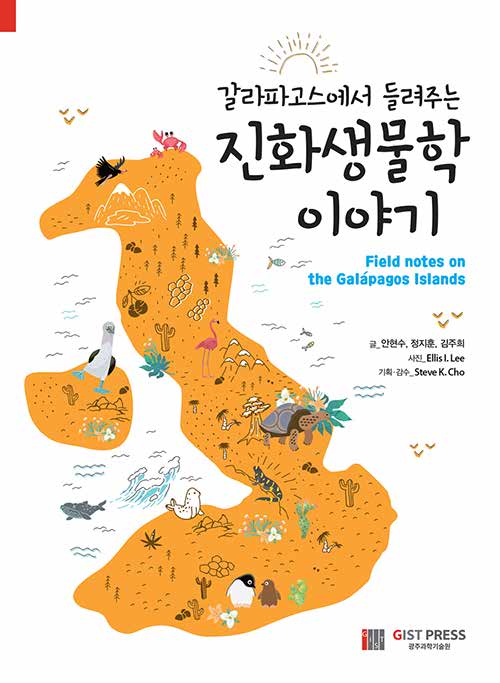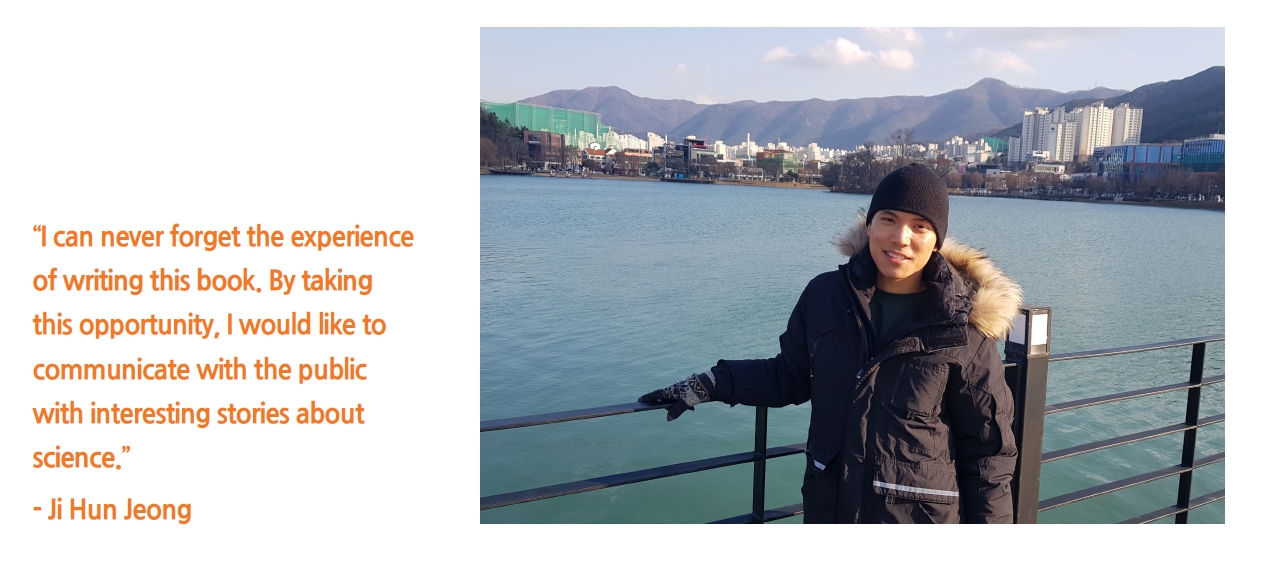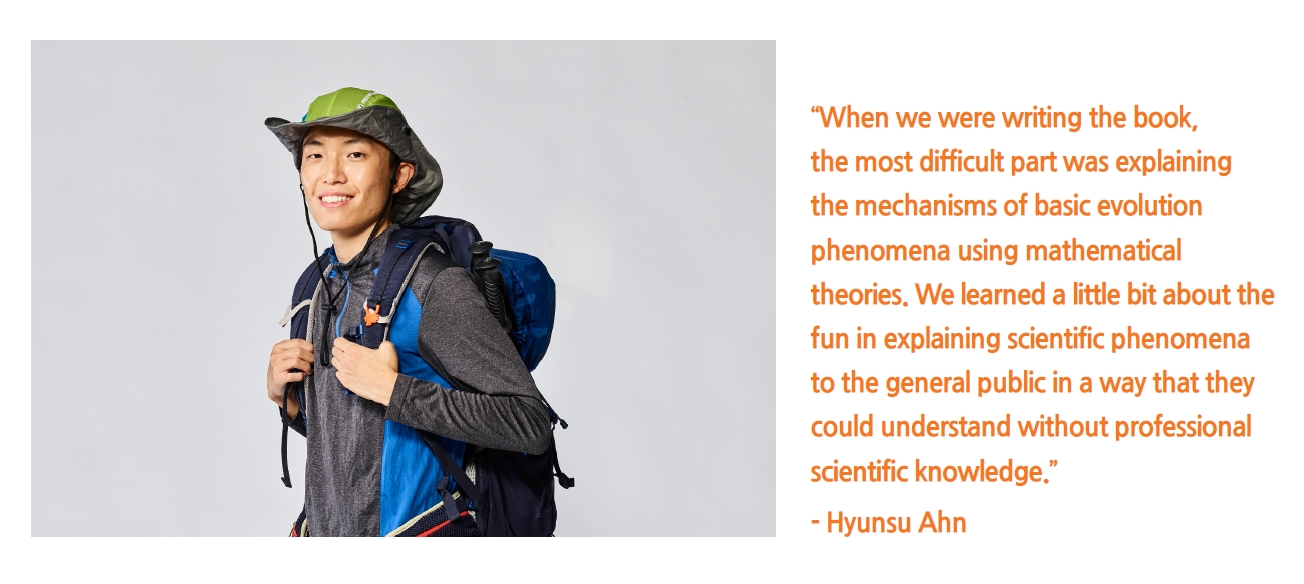Please briefly explain about the book, 『Field Notes on the Galapagos Islands』.
Hyeonsoo
This book contains the field notes we took for our juniors at GIST who would like to participate in the ‘Evolutionary Biology and Field Trip’ program of GIST College and our notes on the evolutionary biology lecture by Professor Rob Phillips that we took at California Institute of Technology. The first part of the draft of the book, which summarized the lecture notes, was written in English to help students who might take this lecture feel more comfortable with the lecture given in English. The field trip to the Galapagos Islands, which is a rare opportunity, is also short and lasts only for a week. We wanted our juniors to look at our field notes and remember important observations we missed and the things that would have been nicer if we had given a little more attention to make their field trip experience a richer one. We completed the second part of the draft by summarizing and supplementing our field notes. Afterward, we reorganized the draft of our book and completed 『Field Notes on the Galapagos Islands』 to share our experiences in the Galapagos Islands with high school students and college students in Korea.
Please tell us about any memorable experience you had when publishing the book.
Hyeonsoo
The environment-friendly tourism policy (ecotourism) of the Galapagos Islands has detailed guidelines on when how many people in a group can enter which area of the Galapagos National Park. When observing the ecosystem of coastal cliffs and coastal mangrove forests on kayak at Santa Cruz Island, we were divided into two groups, one for the morning and one for the afternoon due to the restriction on the number of visitors. We observed the terrestrial ecosystem along the coast by kayaking and walking.
I was not satisfied with the photos I took while kayaking with Ji hunn in the morning, so I decided to go kayaking again in the afternoon. But the kayak turned over three times because it was unstable, and I couldn't take a picture as freely as I wanted. At the end, I couldn't ride kayak anymore and could only take pictures from a distance on a boat. Later, I found out that the kayak was unstable because the weight difference with Ellis, whom I rode the kayak with, was more than 30kg. Now it's just an amusing story, but at the time, it was so embarrassing and disappointing because I had two GoPro cameras but couldn't properly use them.
Jihoon
The process of making a book was not easy, either. When writing, we often had different opinions about which contents to deliver at which level of difficulty. Hyunsus Ahn wanted to describe evolution in more detail, and I wanted to briefly introduce the important concepts of evolution and focus on what we felt visiting the Galapagos Islands in the book. But as all three of us thought about it together and shared our ideas, the contents of the book gradually became richer and developed a character. If I was going to write the book by myself, this book would not have been published.
Could you tell us your favorite part of the book and why?
Jihoon
The part that introduces animals and plants that have adapted to the Galapagos Islands is the most memorable for me. While it is assumed that the flora and fauna of the Galapagos Islands came from the South American continent, they developed characteristics that are completely different from those found in the South American continent as a result of evolution over a long period of time. I think it is a good example that shows the power of evolution.
Juhee
I like the part that introduces the scenery and the feelings I had when I first entered the Galapagos Islands. Because I wrote about feeling quite excited about entering the Galapagos Islands, the excitement at that time still come to life when I read that part.
Hyeonsoo
When we were organizing the contents of the book, I thought it would be nice to include the contents of the interesting papers I read in the Galapagos Islands. We decided to briefly insert the contents of the papers related to evolutionary biology in the middle of the part that summarized our notes about the field trip, using the format like [Learn More]. Personally, I like that part the most.
Did anyone help you publishing the book?
Hyeonsoo
Professor Steve K. Cho, helped us a lot. He asked me to use a GoPro camera to record my experiences in the Galapagos Islands in photographs and videos, and I worked with Ji Hun as a team in there to record our field trip. The day before the last day of the field trip, the professor asked us if we were interested in putting this experience into a book that can help our juniors who might participate in the same program in the future. We decided to leave our experiences in a book.
Joohee
Like Ji Hun mentioned, it was not easy to gather our opinions to publish this book. As undergraduate who have never written a book before, we were quite concerned about the accuracy of the professional contents. We received a lot of help from many people in publishing the book, but particularly, Professor Eunsuk Kim of the School of Earth Sciences and Environmental Engineering gave us feedback on the contents of the book and helped us a lot. We want to take this opportunity to thank him again.
How did GIST help you in publishing the book?
Hyeonsu
After we completed the draft of the book, we received a lot of help from GIST Press regarding the publication of the book. Because none of us had experience in writing books, there were many parts that needed minor revisions in the process of publishing the book. GIST Press accepted and understood most of our revisions to improve the quality of the book.
Joohee
We couldn't have even written the book if we hadn't had the chance to study evolutionary biology at GIST and take a trip to the Galapagos Islands. While it took us about two years to write this book, they waited for us as undergraduates to write the book, and we also went through various review processes together.
Please give some advice to students planning to apply for GIST's global program.
Jihoon
The global program has given me an experience that others rarely have a chance to enjoy. I believe that having a broad perspective with a lot of experiences is also important in becoming an excellent scholar. The global programs can give new inspirations and a sense of direction about the paths you can take in life apart from what you are comfortable and familiar with. I hope you take these opportunities when you can because you might discover new paths in areas you never considered before.




